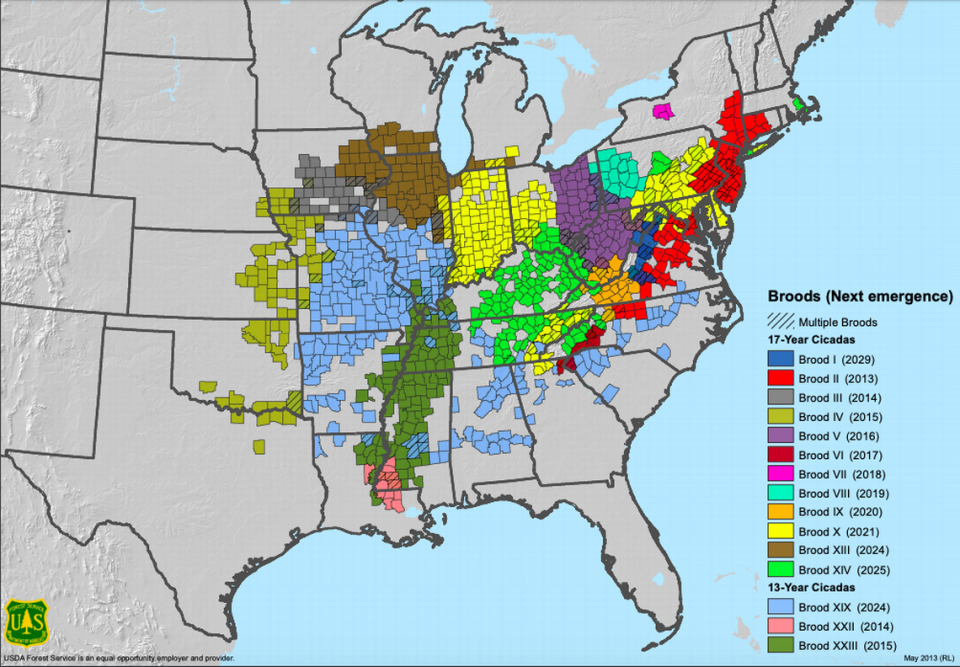Cicadas lurking underground for 17 years will emerge on the East Coast. Here’s where
Tens of thousands — if not millions — of cicadas are expected to ambush parts of the East Coast this month, experts say.
No, it’s not a biblical plague.
This large grouping of cicadas, known as a brood, lives underground for 17 years before finally emerging to mate. Brood IX (9), last seen in 2003, is one of 15 periodical cicadas that emerge every 13 or 17 years, according to the U.S. Forest Service.
What are they?
Cicadas start their lives above ground in eggs that females lay in “tender twigs,” according to bug experts at Orkin, a pest control service based in Atlanta. When the eggs hatch about six or seven weeks later, the “nymph” drops to the ground and starts burrowing.
Nymphs — not fully formed, or “immature,” cicadas — then spend the next 17 years underground.
“The nymph lives underground and feeds on plant roots with its piercing-sucking mouth parts, moving along chambers and tunnels that it digs with its strong, claw-like front legs,” Gene Hall, an entomologist at the University of Arizona, says.
They are not “sleeping or hibernating,” according to Cicada Mania, a website dedicated to the insects.
A cicada relies on “certain environmental cues,” such as ground temperature, to know when it’s time to emerge from below ground, Hall says. It will then climb a tree or building to “shed its final nymphal skin” and become an adult.
The final weeks of their lives above ground are spent trying to mate, according to Cicada Mania. The frequent buzzing sound heard during summer months is the male’s mating call.
“Cicadas are essentially tiny violins with wings,” according to the University of Arizona.
When and where
Brood IX (9) is expected to appear in late May or early June this year, Cicada Mania reports, when the temperature underground climbs to 68 degrees.
“A nice, warm rain will often trigger an emergence,” according to the website.
Cicada Mania breaks down their likely appearance by region.
Alleghany, Bland, Franklin, Henry, Montgomery, Patrick, Pittsylvania and Roanoke counties in Virginia are expected to see some of the brood.
Ashe, Alleghany, Forsyth, Stokes, Surry and Wilkes counties in North Carolina are also on the map, as are Fayette, Greenbrier, Mercer, Monroe, Pocahontas and Summers counties in West Virginia.
The U.S. Forest Service has mapped the locations of all 15 periodical cicadas, most of which are spread out over the Midwest and East Coast.
A different 17-year brood arises almost every year, but rarely in the same spot.

There are, however, a few places where multiple broods overlap.
In Elkin, North Carolina, there are populations of four different cicada broods — Brood VI, Brood IX, Brood X and Brood XIV, according to Magic Cicada. No one knows, however, how much they “are in contact or overlap.”
Why lurk underground for so long?
Cicadas might be much smarter than humans think.
In trying to answer why these broods of insects spend so much time underground, scientists have noted they emerge in prime years — 13 or 17.
Their life cycle is unlike any other species found in nature, a 2004 paper on their “evolutionary strategy” states.
“The general consensus is that the long, prime-numbered life-cycle makes it difficult for an above-ground animal predator to evolve to specifically predate them,” according to Cicada Mania.
Parasites with a shorter life cycle would only meet a cicada with a 17-year life cycle “one time out of hundreds of years,” the paper states.
“This would lead to the extinction of the parasites if they depend on the cicadas to reproduce,” researchers said. “In fact no specific periodic predator to cicadas has been found to date.”

